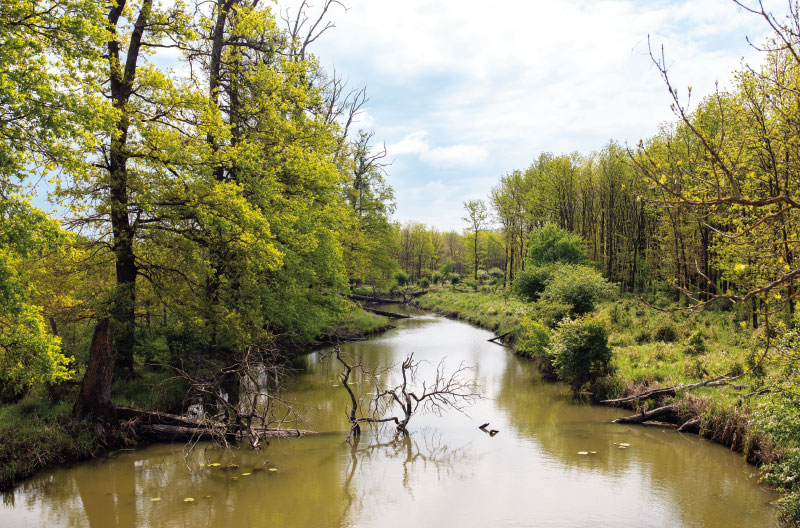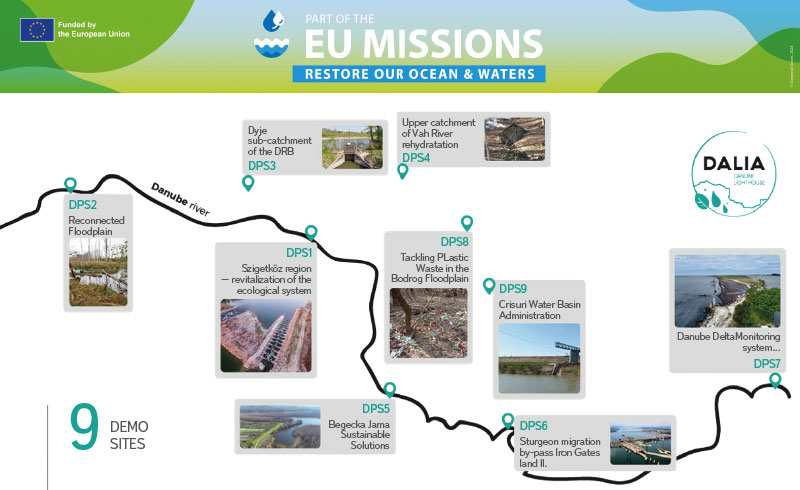
Accessible and high-quality water is a natural resource essential for life, well-being, and social prosperity. After decades of intensive exploitation, pollution and socio-economic pressure, Europe’s freshwaters and seas are at risk of degradation. This has to be seen not only as a potential dramatic loss from an economic point of view, but also it means unpredictable ecological, social, and cultural damage.
The European Commission has responded to this challenge by creating the research and innovation mission Restore our oceans and waters; with a 2030 target, the aim is to provide a systemic approach for the restoration, protection and conservation of oceans and freshwater. In 2022–2025, a development and pilot phase has been underway, during which four so-called Mission Lighthouses were launched. “The Danube Regional Water Lighthouse Action” (DALIA) aims to significantly contribute to the improvement of the state of the Danube basin; it is financed by the European Union under the Horizon Europe programme with
a total subsidy of € 8,499,236. The basin is home to almost 80 million people and extends over 19 European countries, which is exceptional even on a global scale.
The project consortium is coordinated by the Hungarian General Directorate of Water Management (OVF) and consists of 22 institutions from nine European countries (eight from the EU). The consortium is developing an integrated tool to improve decision-making mechanisms and to more effectively restore freshwater and transitional ecosystems in the Danube basin. It also participates in cooperation with a wider network of related national and EU-funded missions and projects. As part of the work packages, there are nine pilot sites addressing various issues of the Danube and its tributaries. These include, for example, pollution by the introduction of micropollutants, municipal waste, a change in the natural physical parameters of the watercourse (e.g. temperature), and the maintenance of a minimum residual flow.
The integrated web-based tool will benefit from the knowledge and experience transferred from individual pilot sites, located along the watercourse up to the delta on the Romanian-Ukrainian border. In this area, which is a UNESCO biosphere reserve, research is focused on sediment transport and accumulation and reducing municipal waste inputs, especially plastics. A pilot area on the Bodrog River in Hungary is facing a similar problem; here, the contamination of micro and macro plastics is also compounded by the legacy of toxic load from former mining activity.
In Slovakia, the Danube hydrology is influenced by rainwater management practices in rural areas. The underestimated impact of erosion leads to reduction of water resources in the upper parts. The drying up of spring areas and small watercourses during recurring long-lasting drought affects the overall river flows in the area.
In the lower part of the Danube, the focus is on river connectivity enabling sturgeon migration. As part of the project, a strategy will be proposed to help sturgeons pass upstream through Iron Gates I and II. This includes a special solution for each hydroelectric power station and tracking the movement and behaviour of sturgeon using ultrasound. Monitoring will be carried out by three fixed gates and ships on more than 700 river kilometres.
Another demonstration site on the Danube left bank includes Begečka Jama Nature Park and the Begeč-Gložan drainage system. Pollutants from agriculture and wastewater threaten the local ecosystem stability. For secondary wastewater treatment, a constructed wetland system is used here, which acts as a biofilter to remove pollutants and pathogens. This, along with careful monitoring, aims to improve the area’s environmental health.
The research team of the TGM WRI Department of Hydrology (Ing. Adam Vizina, Ph.D., Ing. Adam Beran, Ph.D., and Ing. Petr Pavlík) is participating in the project mainly via research in the Dyje pilot basin with special emphasis on the Soutok site. In this area, a comprehensive restoration measure is currently underway – Obnova přirozeného vodního režimu revitalizační soustavy v EVL Soutok-Podluží (Restoration of natural water regime of the revitalization system in Soutok-Podluží SAC); its purpose is to improve the water regime in Soutok-Podluží SAC. It includes 14 actions; the most significant is the construction of a transverse object – a flap gate weir, which will enable a substantial increase in the amount of water released into the alluvial forest through existing infiltration structures. The pilot site is studied within the proposed modifications and its character is evaluated with a view to simulated climate change scenarios.
The project team is developing a robust online tool for calculating and comparing the minimum residual flow (MRF) and is involved in hydrological modelling tasks in the context of future climate scenarios. It is also coordinating the creation of a summary report on implemented technical measures in pilot sites and links the activities of related projects.
At the time of writing the article (June 2024), DALIA Rivers Revived call was taking place. It was an open call for associated regions within the “Danube Regional Water Lighthouse Action” project. Detailed information about the project can be found at https://dalia-danube.eu/.

This informative article has not been peer-reviewed.
